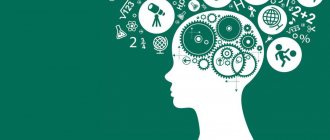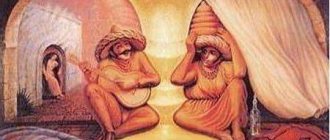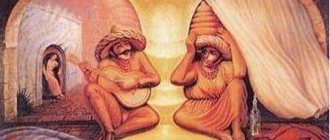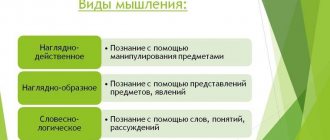Cognitive mental processes
Definition 1
Cognitive or cognitive processes are a type of mental processes that are associated with the perception and processing of data coming from outside. Cognitive processes perform the most important function; they ensure the interaction of the individual with the external environment.
The science that studies cognitive processes is called cognitive psychology.
Cognitive processes include the following forms of perception and processing of information:
- feeling,
- perception,
- memory,
- imagination,
- attention,
- thinking,
- speech.
Let's look at each process separately.
Interaction of memory and speech
Speech and memory are closely related. If memory and speech function properly, a person can share experiences and reproduce accumulated knowledge and skills. Speech is a mental process, the highest mental function that ensures communication between people. Memory, in turn, accumulates, stores, and then reproduces previously received information. It should be noted that it is speech and, along with it, memory that actively develops in preschool age.
It should be noted that speech is largely associated with logical memory. It is easier to remember what was expressed in linguistic form.
Speech helps sensory memory, which most often does not last long.
When a person perceives or generates speech, he turns to his memory. Without memory, a person would not be able to communicate, since he would not remember the meaning of words.
Feel
Sensations are the main source of information about the outside world and about one’s own body; they are one of the main conditions for psychological development. Sensations are channels through which information about environmental phenomena and body conditions reaches the brain. They allow a person to navigate the outside world and his body.
Are you an expert in this subject area? We invite you to become the author of the Directory Working Conditions
All sensations can be divided into three main types:
- Interoceptive is a type of sensation in which signals from the internal environment provide regulation of elementary drives. They provide information about the internal state of the body. These include a feeling of hunger, a feeling of discomfort, a feeling of calm, etc.;
- Proprioceptive - a type of sensation that provides regulation of body movements and provides information about the position of the body in space;
- Extraceptive is a type of sensation that is the basis of a person’s conscious behavior. They are conventionally divided into contact and distance. Contact sensations arise from the direct interaction of a stimulus with the corresponding perceived organ. These include taste and touch. Distant sensations occur when a stimulus and a sensory organ interact at a certain distance. These are sensations such as smell, hearing and vision.
Ways to build new images
The transformation of reality in the imagination is carried out by methods; called "techniques" of imagination . These include:
Combination , the combination of data in the experience of elements in new, more or less unusual combinations. This is the simplest technique of imagination, and it is what researchers of the past had in mind when they considered associations to be the mechanism of imagination.
Agglutination, a combination option in which a non-random set of traits is subject to combination, undergoes a direct selection of them according to a specific plan, concept.
Accentuation , emphasizing certain features of a phenomenon, which transforms its overall appearance. It should highlight the characteristic, essential, important.
Hyperbole and litotes - Changes in magnitude, quantitative growth and decrease - are special options for emphasis (very large or very small in relation to reality are emphasized. When in the imagination there is immediately an increase in some sides and a decrease in others, we are talking about polarization.
Idealization , The construction of idealized images free from all petty things, which sometimes cause the illusion of exclusivity and perfection of a certain phenomenon. The main essence of dreams lies in the pursuit of ideal.
Typification , Specific generalization. Through the concrete in the image that appears to the type, the generally significant is highlighted.
Alegorization, Creation of allegory - the use of an image in a figurative sense. An image acts only as a conventionally chosen sign of some phenomenon of reality.
Metaphorization , Construction of metaphors. A metaphor is a deeper mental representation of a phenomenon than an allegory, since there is a certain similarity and analogy between the metaphorical image and its meaning.
Symbolization , the use of symbols, is the most profound, essential filling of the imagination technique. Understanding the language of symbols helps a person consciously receive messages from his own unconscious (dreams, etc.). A symbol differs from a sign in that it is not conventionally chosen to designate, but is deeply, essentially united with what it denotes. Unlike a concept, a symbol has an unlimited amount of meaning. Only the universal, due to the very way of human existence, can be expressed through symbols.
In the technique of imagination, a complex dynamic unity of the conscious and unconscious is always created.
Perception
Perception is the synthesis of individual isolated sensations into a holistic image. Perception is a complex and active process of reflecting objects and situations, in which the main features of an object are determined and combined into a complex. Next, this group of features is compared with the information received about the subject. If the data matches, the object is recognized and the perception process is completed.
Finished works on a similar topic
Course work Cognitive mental processes 470 ₽ Abstract Cognitive mental processes 240 ₽ Test work Cognitive mental processes 200 ₽
Receive completed work or specialist advice on your educational project Find out the cost
To divide things into different categories with a specific description of their properties and characteristics, a person uses speech. He names the perceived object with a specific word. This indicates the closeness of perception and thinking.
Fantasy as a creative process
Fantasy - (Greek tsbnfbuYab - imagination) - a situation imagined by an individual or group that does not correspond to reality, but expresses their desires; an unreal combination of real elements; a dream, a product of the imagination. Fantasies can be of any nature.
There are active and passive fantasies; the former are caused by intuition, that is, an attitude aimed at the perception of unconscious contents, and libido immediately occupies all elements emerging from the unconscious and brings them, through the association of parallel materials, to complete clarity and visibility; passive fantasies appear immediately in a visual form, without a preceding or accompanying intuitive attitude, with a completely passive attitude of the cognizing subject. Such fantasies belong to mental “automatisms”. Passive fantasy always arises from some process in the unconscious; active fantasy owes its existence to the participation of consciousness.
With the help of fantasy, a person can get used not only to the images of other people, but also to any images of objects and phenomena, transforming their nature. These can be images of living beings, then a person endows them with human traits, personifies them. This is what a fabulist does, for example. If objects are images of inanimate objects, then fantasy can give them the appearance of animate beings.
The very nature of creative activity, which reveals something new and unknown, presupposes the desire to look into the future and anticipate the result of the activity. This is what fantasy does, performing a prognostic function. The motives of fantasy, in principle, coincide with the motives of creative activity. First of all, this is the need for search activity, the desire for novelty, the unusual, the unpredictable. Another motive for fantasy is often unsatisfied desires of various kinds. The motive of self-expression, the desire to assert one’s personality, is also essential.
Creative imagination is original, independent, active and purposeful. Other types of fantasy - dreams, daydreams, recreating fantasy (according to the description) are characterized by passivity and whimsicality. This is, for example, the fantasy of viewers and listeners of a work of art.
When imagining, the child himself creates any plot he wants, including a fairy tale, any situation he wants, any problem he wants, and solves it himself in any way he wants. Any solution is acceptable. And when solving real problems, the child is looking not for any solution, but for a real, “adult”, serious, feasible solution. In both cases, he creates, but with fantasy there is more freedom, since there are no prohibitions from physical laws and much knowledge is not required. But the main thing is not to “overdo it” with fantasy, so that the fantasy does not become stupidity. Stupidity is an unnecessary, unreasonable, incorrect, harmful, inappropriate act or statement that does not bring honor to the one who committed it. Of course, one must take into account the person’s age, conditions and goals of the action.
The classic vehicle of fantasy is the fairy tale. What is the difference between a fairy tale and science fiction? In science fiction, technically feasible situations, elements or processes are considered, and in a fairy tale, any. It should be noted that there is also no sharp boundary between fantastic and real solutions. For example, what was considered fantasy in the time of Jules Verne is now everyday reality. G.A. Altshuller calculated that out of 108(!) ideas and forecasts of J. Verne, 99 (90%) were implemented. Herbert Wells has 77 out of 86, Alexander Belyaev has 47 out of 50 [Altshuller G.S. Human life 1-4-502 // TRIZ Magazine. -1996. — No. 2. - p.44-52; 1997. - N1. - p.4-15].
When a child selflessly tells fables with his own participation, he is not lying; in our usual understanding, he is composing. It doesn't matter to him whether it's real or not real. And this shouldn’t be important to us, what’s important is that the child’s brain works and generates ideas. However, you should still pay attention to what the child dreams of. If he talks all the time about his non-existent friends, about affectionate parents or about toys, then perhaps he suffers, dreams about it and thus pours out his soul.
Memory
Memory is the imprinting, preservation and reproduction of traces of previous experience, allowing the accumulation of information after certain phenomena have disappeared. Memory extends to intellectual, motor and emotional activities.
According to the process of formation, memory is conventionally divided into short-term and long-term. With short-term memory, traces of the events that occurred have been formed, but have not yet been strengthened, and with long-term memory, traces have been formed and are so strengthened that they can be preserved for a long time and are resistant to the influence of various influences.
Imagination
Imagination is understood as a cognitive process in which objects and phenomena at a given moment in time are not perceived by the senses, but are formed on the basis of the experience gained. Imagination is closely related to memory and is characteristic only of humans. It can affect body function and movement.
They distinguish involuntary imagination, i.e. the formation of images without any human effort, and voluntary imagination, in which an individual deliberately tries to imagine something specific. Dreams are a special type of imagination. A dream is a conscious process of creating images of what is desired; they show what is important to a person and what he strives for.
The emergence of psychology as a science
Since ancient times, the needs of social life have forced a person to distinguish and take into account the peculiarities of the mental make-up of people. The philosophical teachings of antiquity already touched upon some psychological aspects, which were resolved either in terms of idealism or in terms of materialism. Thus, the materialistic philosophers of antiquity Democritus, Lucretius, Epicurus understood the human soul as a type of matter, as a bodily formation formed from spherical, small and most mobile atoms. But the idealist philosopher Plato understood the human soul as something divine, different from the body. The soul, before entering the human body, exists separately in the higher world, where it cognizes ideas - eternal and unchanging essences. Once in the body, the soul begins to remember what it saw before birth. Plato's idealistic theory, which interprets the body and psyche as two independent and antagonistic principles, laid the foundation for all subsequent idealistic theories.The great philosopher Aristotle, in his treatise “On the Soul,” singled out psychology as a unique field of knowledge, and for the first time put forward the idea of the inseparability of the soul and the living body. The soul, the psyche, manifests itself in various abilities for activity: nourishing, feeling, moving, rational; Higher abilities arise from and on the basis of lower ones. The primary cognitive ability of man is sensation; it takes the forms of sensory objects without their matter, just as “wax takes the impression of a seal without iron and gold.” Sensations leave a trace in the form of ideas - images of those objects that previously acted on the senses. Aristotle showed that these images are connected in three directions: by similarity, by contiguity and contrast, thereby indicating the main types of connections - associations of mental phenomena.
Thus, stage I is psychology as the science of the soul. This definition of psychology was given more than two thousand years ago. They tried to explain all the incomprehensible phenomena in human life by the presence of a soul.
Stage II - psychology as a science of consciousness. It appears in the 11th century in connection with the development of natural sciences. The ability to think, feel, desire was called consciousness. The main method of study was a person's observation of himself and the description of facts.
Stage III - psychology as a science of behavior. Appears in the twentieth century. The task of psychology is to conduct experiments and observe what can be directly seen - namely, human behavior, actions, reactions (the motives causing actions were not taken into account). Stage IV - psychology as a science that studies objective patterns, manifestations and mechanisms of the psyche.
The history of psychology as an experimental science begins in 1879 - the world's first experimental psychological laboratory was founded in Leipzig by the German psychologist Wilhelm Wundt. Soon, in 1885, Bekhterev V.M. organized a similar laboratory in Russia.
Attention
Attention is the selection of the necessary information and ensuring the selective nature of conscious activity. A person is able to select the most important and necessary things from the huge flow of information that surrounds him. At the same time, the amount of attention is allocated, i.e. the number of incoming signals from stimuli that predominate and remain in the center of consciousness. Attention is also characterized by stability - this is the time for which certain processes prevail in consciousness.
Thinking
Thinking is the process of reflecting reality in its essential connections and relationships and the formation of new knowledge. Thinking is a complex and important cognitive process, as a result of which a thought is formed. Thinking is classified into the following types:
- Visually effective. It arises in practice when performing operations that require mental activity;
- Visual-figurative. It is based on ideas and images;
- Verbal-logical. It is based on abstract processes that operate with logic and concepts.
Mental operations
The main mental operations are distinguished:
- analysis,
- comparison,
- synthesis,
- generalization
- abstraction , etc.
► Analysis is a mental operation of dividing a complex object into its constituent parts or characteristics.
► Comparison is a mental operation based on establishing similarities and differences between objects.
► Synthesis is a mental operation that allows one to mentally move from parts to the whole in a single process.
► Generalization is the mental unification of objects and phenomena according to their common and essential characteristics.
► Abstraction (distraction) is a mental operation based on highlighting the essential properties and connections of an object and abstracting from other, unimportant ones.









